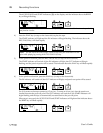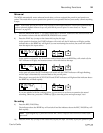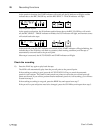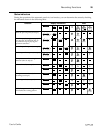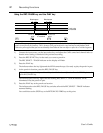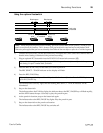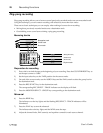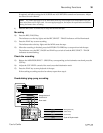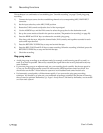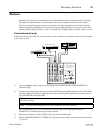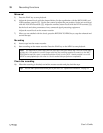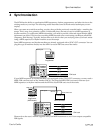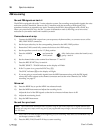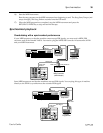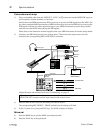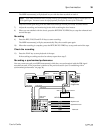
31 Recording Functions
User’s Guide
This technique is a combination of overdubbing (see "Overdub recording" on page 15) and ping-pong
recording.
1) Connect the input source for the overdubbing channel to its corresponding MIC/LINE INPUT
connector.
2) Set the input select key to the MIC/LINE position.
3) Rotate the GAIN control to adjust the level of the input signal.
4) Use the ASSIGN keys and the PAN control to select the group bus for the destination track.
5) Set up the source tracks as listed in the previous section ("Preparation for recording" on page 29).
6) Press the REHE and PLAY keys to rehearse the overdub/ping-pong.
Play along with the tape. Adjust the channel fader, PAN controls, and equalizer controls for each
source and input channel.
7) Press the RETURN TO ZERO key to stop and rewind the tape.
8) Press the REC/PAUSE and PLAY keys to start recording. When the recording is finished, press the
RETURN TO ZERO key to stop and rewind the tape.
9) Check the recording.
Ping-pong notes
• Avoid ping-pong recordings to an adjacent track (for example, avoid bouncing track 2 to track 1 or
track 3) as much as possible. Otherwise, crosstalk (the signal leak at the record/playback head) may
cause feedback.
• If you must ping-pong to an adjacent track, set your recording levels carefully. Set the tape speed to
9.5 cm/sec for the highest quality sound. Do not boost the HIGH equalizer control too much. You
should also use the dbx™ noise reduction system to avoid feedback and control noise levels.
• Unfortunately, sound quality will deteriorate rapidly if you overuse the ping-pong recording
technique. You should try to plan out your multitrack recording to minimize the amount of bouncing
that you need to perform. Remember, Sgt. Pepper’s Lonely Hearts Club Band by the Beatles, was recorded
on a four-track system!



